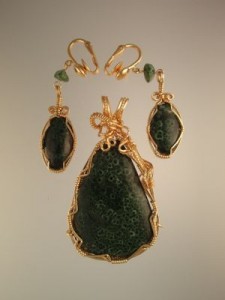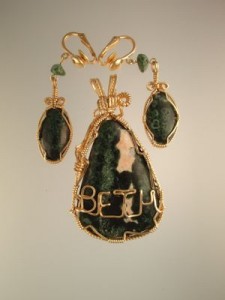Michigan’s State Gem, the Isle Royale Greenstone, 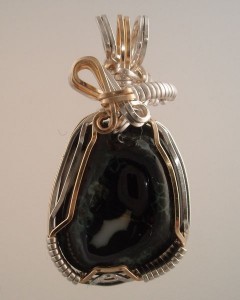 is unquestionably one of the rare minerals of earth. It can only be found on Isle Royale National Park and in Michigan’s Keweenaw Peninsula. Greenstone is a close relative of Epidote. Chlorastrolite (translated from Greek as green, star-like stone) is actually a form of Pumpellyite. “Chlorastrolite” was adopted as Michigan’s gem March 30, 1973.
is unquestionably one of the rare minerals of earth. It can only be found on Isle Royale National Park and in Michigan’s Keweenaw Peninsula. Greenstone is a close relative of Epidote. Chlorastrolite (translated from Greek as green, star-like stone) is actually a form of Pumpellyite. “Chlorastrolite” was adopted as Michigan’s gem March 30, 1973.
Greenstone formed in amygdaloidal pockets of Keweenaw basalts. At one time Isle Royale and the Keweenaw formed one land mass. Isle Royale was spit off from the Keweenaw when the rift that formed Lake Superior split a giant gash in the earth.
Thanks to Benjamin Franklin, the Keweenaw Peninsula and Isle Royale are part of the United States. Franklin was a member of the commission that drew up the boundaries for the Treaty of Paris in 1773, ending the Revolutionary War. Ben Franklin had heard of the rich mineral deposits in the Keweenaw and Isle Royale so he drew the boundary line to the north of Isle Royale, giving this area to the United States instead of Canada.
The mineralization on Isle Royale is exactly the same as the Keweenaw. Native copper, Datolite, Prehnite, Thomsonite, Lake Superior Agates, Epidote, Greenstones, and the same basalts are seen in both locations.
Basalt 101-
As the basalts cooled, gasses tried to escape to the surface, the bubbles becoming smaller and smaller as they rose and tried to escape from the basalt’s clutches. The basalt hardened and trapped these bubbles known as “vesicles”. Also the cooling created shrinking and cracking of the basalt. These cracks in the basalts allowed different minerals in solution to flow into the vesicles, where they eventually solidified.
Copper, silver, arsenates, and other metals also filled the cracks and vesicles, but were disseminated by rising, super heated water instead of flowing down from the surface. The vesicles that the copper and other metals filled were sometimes huge and other times just cracks or small bubbles.
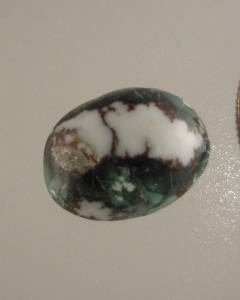
Greenstone with Datolite and Copper
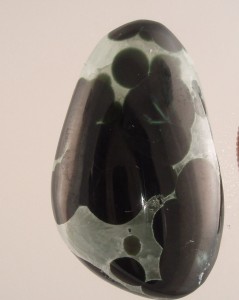
Greenstone with Prehnite
Copper associated itself with other minerals including all the previously mentioned material. The variety of material, mixed in different ways, is what makes this rock hunting area so intriguing. It is wonderful to see copper running through Greenstone, Datolite, Prehnite, and Lake Superior agates. Pieces of Greenstone/copper are highly coveted by collectors and jewelry makers like myself. The few pieces I have are priceless. My wife has a ring made out of one of these copper/greenstone pieces, and I still have a couple specimen pieces. She sometimes wears the ring to art shows, so ask her if you see us. To see an example of copper with datolite, take a look at my Copper Lightning Datolite.
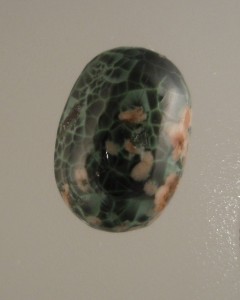
Greenstone with Thomsonite
Greenstone sometimes has Thomsonite inclusions, which make for a spectacular look. (Dark, chatoyant green and dark pink together) I’m waiting to find a Copper-Greenstone-Thomsonite some day. I have seen specimens of these at the Seaman Museum at Michigan Tech.
My next post will discuss finding and working with greenstones.


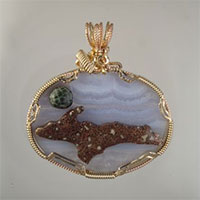
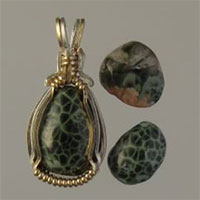
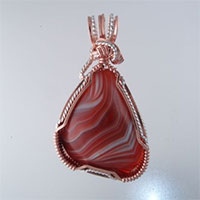
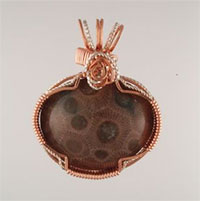
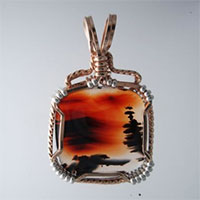
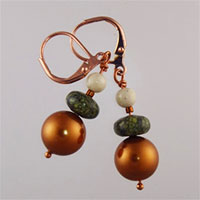
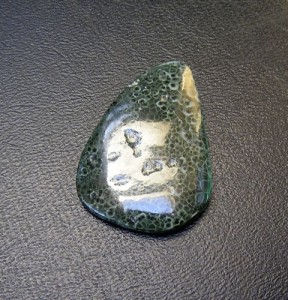 This Greenstone was larger than any I have seen anywhere, even at the
This Greenstone was larger than any I have seen anywhere, even at the 